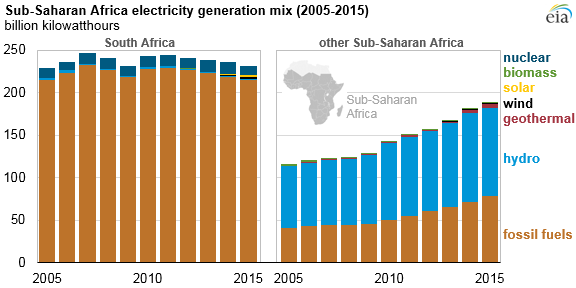Fossil Fuels and Hydro, Not Wind or Solar, Power Sub-Saharan Africa
Access to electricity has increased dramatically in Sub-Saharan Africa. This is incredibly good news, because more than 600 million people, nearly double the population of the United States, still live with no electricity.
In what should be a surprise to absolutely no one, the vast majority of this electricity was provided by fossil fuels and hydro electric power, and this is exactly how it should be.

Imagine you were building an electric grid from scratch.
What qualities would be the most important to you? If you were living without any electricity, your top priorities would probably be being able to refrigerate and freeze food, be able to power life-saving equipment at hospitals, and power street lamps so you feel safe walking the streets at night.
For each of these tasks, wind and solar are incredibly ill suited, mostly because they do not provide around-the-clock access to electricity. This is why American hospitals have generators that run on diesel, a fossil fuel, to provide electricity and run the life-saving equipment their patients need if the power goes out.
Refrigeration isn’t simply a luxury, it is a matter of public health. Refrigeration dramatically slows the growth of microorganisms such as the Listeria monocytogenes bacterium, and halts the development of most pathogenic germs such as Salmonella enterica. Refrigeration also prevents food from spoiling, which effectively increases the availability of food and facilitates the movement of food long distances.
Having a refrigerator flicker on or off with the vagaries of the wind or sun would be an unacceptable design for anyone creating an electric grid from scratch. There is simply too much variation and too little dependability with wind and solar to build a sustainable grid with a steady supply of electricity.
Keeping this in mind, it should come as no surprise that the African nations with the best access to electricity have the best economies. South Africa, for example, was by far the largest electricity consumer in the region, accounting for about 56% of consumption. South Africa also accounted for more than 5% of SSA’s population and generated about 20% of SSA’s overall gross domestic product in 2016.
Now, think back to Minnesota. Wind and solar boosters talk about these sources of electricity replacing fossil fuels, but is this really possible? Would we be willing to live in a world without refrigeration, street lamps, or life-saving hospital equipment? I certainly hope not.
Regardless of how many wind turbines or solar panels we install, we will still depend on natural gas or coal fired power plants to provide electricity when the amount of electricity generated from wind or solar reaches zero, which happens every single day with solar power.
All this goes to show that wind and solar can never realistically “replace” fossil fuels. Maybe this changes if battery technology can somehow make renewables+storage cheaper than actual fossil fuels, but this is incredibly unlikely to occur, in my view.
Long story short, people’s lives are improving because of fossil fuels and hydro power, and we should celebrate this achievement rather than fret about our carbon footprint.